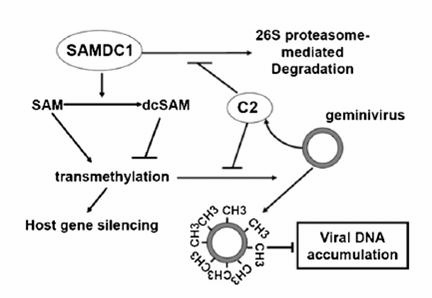Plant viruses are excellent tools for studying microbial-plant interactions, as well as the complexities of host activities. A research team, led by Dr. Qi Xie, found that the protein C2 encoded by Beet severe curly top virus (BSCTV) played a very important role in the virus-plant interaction.
Using BSCTV C2 as bait in a yeast two-hybrid screen, a C2-interacting protein SAMDC1 was identified from an Arabidopsis cDNA library. The interaction was confirmed by an in vitro pull-down assay and a firefly luciferase complemention imaging assay in planta. Biochemical analysis further showed that the degradation of the SAMDC1 protein was inhibited by MG132, a 26S proteasome inhibitor, and that C2 could attenuate the degradation of the SAMDC1 protein. Genetic analysis showed that loss of function of SAMDC1 resulted in reduced susceptibility to BSCTV infection and reduced viral DNA accumulation, similar to the effect of BSCTV C2 deficiency. Bisulfite sequencing analysis further showed that C2 deficiency caused enhanced DNA methylation of the viral genome in infected plants. Moreover, C2 can suppress de novo methylation in the FWA transgenic assay in the C2 transgene background. Overexpression of SAMDC1 can mimic the suppressive activity of C2 against GFP-directed silencing. These results suggest that C2 interferes with the host defense mechanism of DNA methylation-mediated gene silencing by attenuating the 26S proteasome-mediated degradation of SAMDC1.
This is the first work in plant to address how virus protein regulates host de novo methylation through affecting 26S mediated ubiquitin degradation pathway. This research was published in Plant Cell on January 18, 2011, and the feature editor of the journal wrote the “In Brief” for this article. The Ph.D student Zhonghui Zhang in Dr. Xie’s lab is the first author of this work.
AUTHOR CONTACT:
XIE Qi, Ph.D.
Institute of Genetics and Developmetnal Biology, Chinese Academy of Sciences, Beijing, China.
E-mail: qxie@genetics.ac.cn
 |
|
Proposed Model for C2 and SAMDC1 Interaction in the Regulation of Transmethylation-Mediated Gene Silencing and Geminivirus Infection.
The machinery of host DNA methylation may modify the geminivirus genome and inhibit viral DNA accumulation. This model proposes that BSCTV C2 attenuates the 26S proteaosome-mediated degradation of SAMDC1 to positively regulate cellular SAMDC activity, thereby leading to an altered SAM/dcSAM ratio. The change in the SAM/dcSAM ratio futher inhibits the DNA methylation of geminivirus DNA and promotes viral replication. This process is associated with DNA hypomethylation and the release of gene silencing in some loci of the host genome. |



